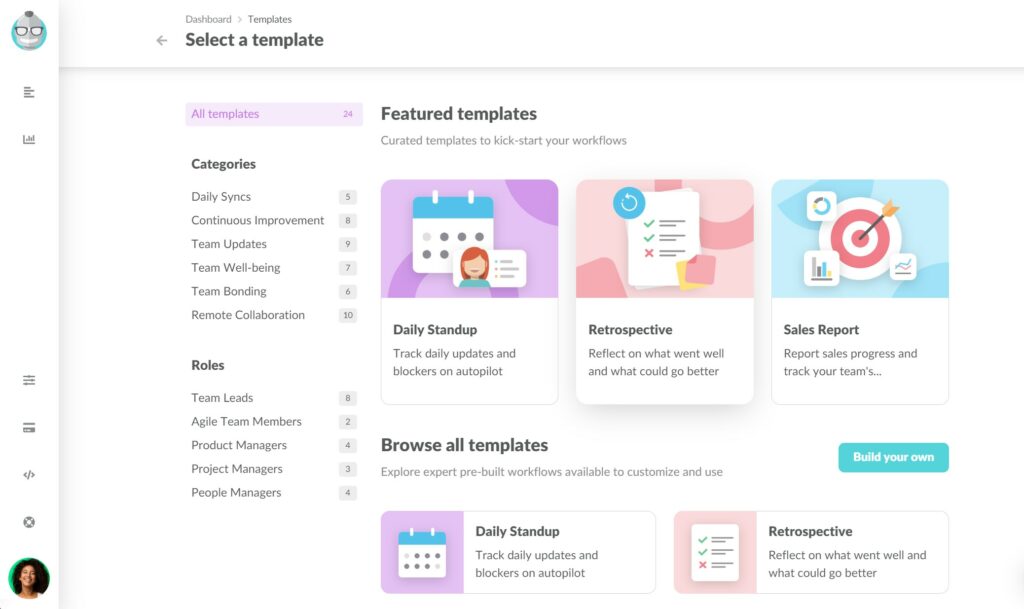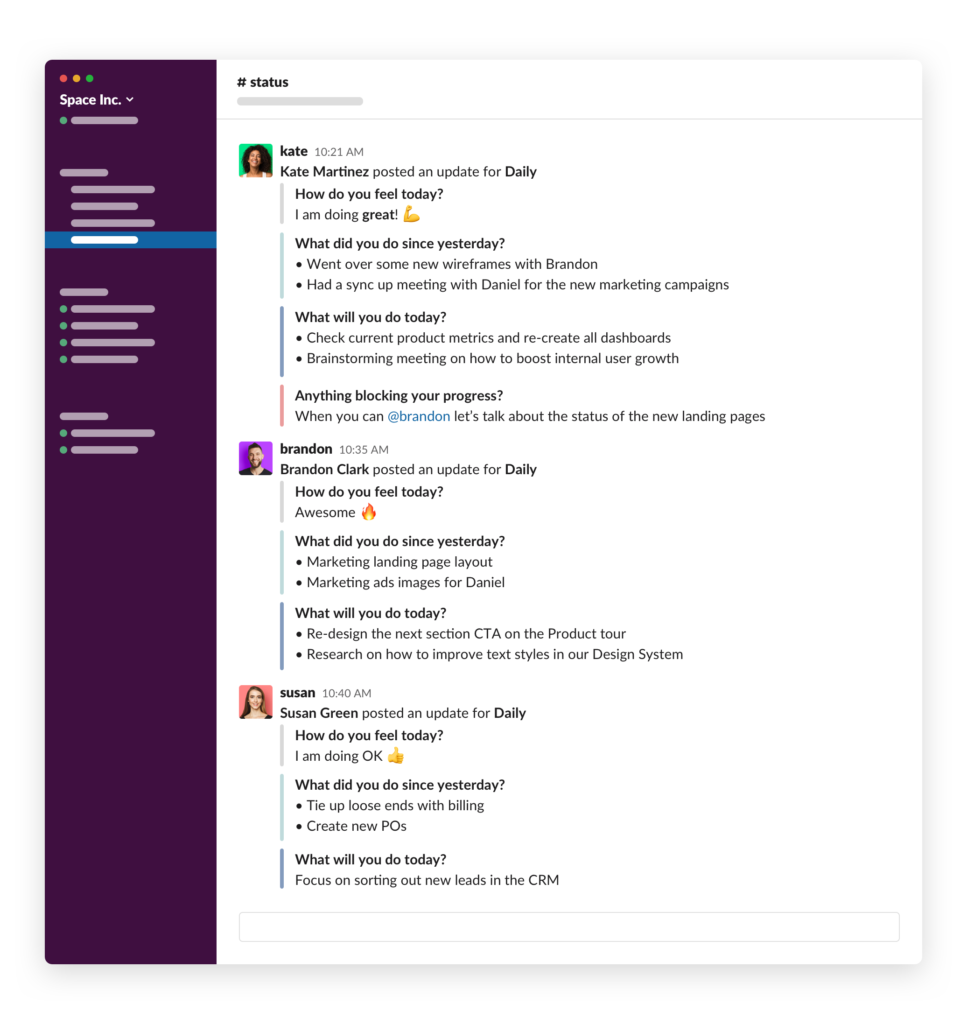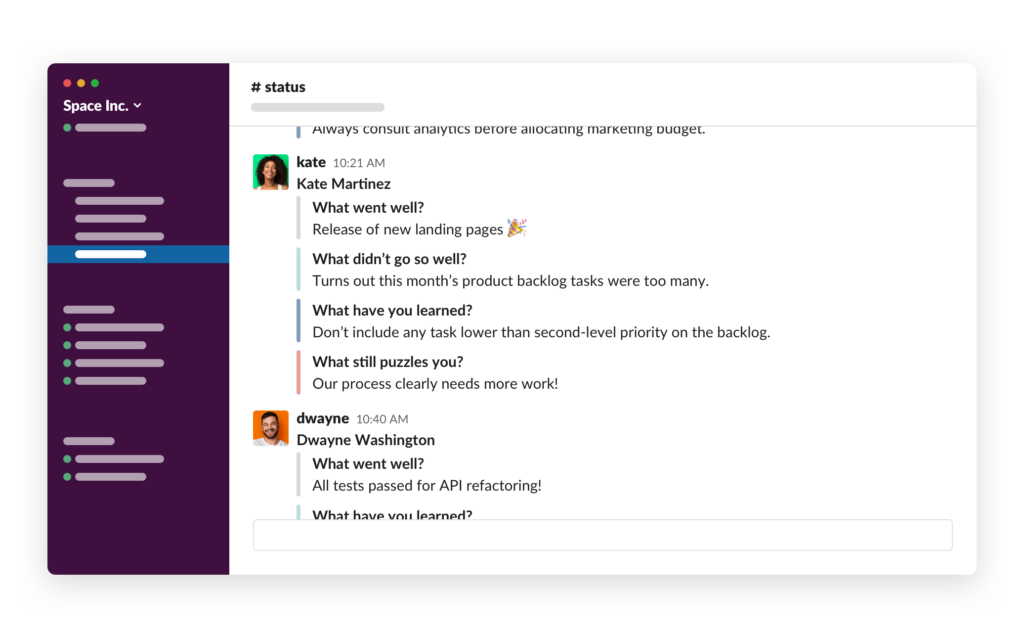Scrum meetings are an integral part of Scrum. In a way, Scrum IS its meetings. But don’t let that fool you: not every meeting automatically becomes a Scrum meeting simply because you labeled it that way.
Every Scrum meeting has a particular goal and structure that Agile practitioners have been perfecting for years. That’s why even minor alterations can completely de-value Scrum meetings and even render them useless.
In this guide, we’ll go through three pivotal Scrum meetings: Daily Scrum, Scrum Retrospective, and Sprint Planning.
We’ll share advice on how to run them in the most effective way, why they work, and how you can adapt them to your work environment.
Let’s dive in.
Scrum Meeting #1: Daily Scrum or Daily Standup Meeting
Even though there are several types of Scrum meetings, when people refer to the “Scrum meeting,” they usually mean daily standups.
These daily meetings are the backbone of any Scrum operation. Daily standups are immensely popular, and even non-Scrum teams make them part of their workflow because of their simplicity and efficiency.
What Is a Daily Standup Meeting:
A daily standup meeting is a short, time-framed meeting that should typically last 15 minutes or less. It consists of three defined questions that every team member answers:
- What did you do yesterday?
- What will you do today?
- Anything blocking your progress?
On the surface, these questions seem simple. But when all Scrum team members answer these questions daily, everyone knows who works on what, where the team is moving, and the main issues that prevent teams from being productive.
The ongoing benefits of regular daily standup meetings include enhanced team collaboration and consistent individual productivity. In addition, dally standups help teams to replace several unproductive meetings with one short.
Common Daily Standup Mistakes:
- Long daily standups. Daily scrums need to be effective and short. A common mistake for daily standup practitioners is to follow up on any roadblocks and discuss them in the same meeting. Such discussions, if needed, should be scheduled as follow-up discussions.
- Daily standups that are “status meetings” in disguise. Inefficiency managers tend to disguise status meetings as daily standups, but these meetings serve different purposes. A manager should never be the center of these meetings, as these meetings serve as a way for team members to self-organize and achieve their Sprint goals.
That’s why daily scrum meetings are not 100% efficient without other scrum meetings and without broader Agile methodology in use.
Daily Standup Best Practices:
- Asynchronous standups. The best way to ensure that your daily standups are short and effective is to run them asynchronously. That means every team member can ask standup questions at their own time without having to wait for others to voice their responses.
- Take regular meeting notes. Even after a week of taking short notes of what everyone said during daily standups can give your team a clear view of progress, recurring issues, and patterns. This information is invaluable in making your team more productive in the long term.
- Add the 4th question. Some Agile teams add the 4th question before the main three to warm up participants and make standups more engaging and fun. That leads to more interesting conversations and a higher level of trust and collaboration.
How to run asynchronous Daily Scrum Meeting in Slack with Geekbot:
1. Open Geekbot dashboard and choose Daily Standup templates:

2. Configure when do you want your team members to receive standup questions in Slack and who will receive them:

Tip: you can send questions at the user’s local time. This is especially useful for teams distributed over several time zones so that everyone can answer questions at the same time of day.
3. At the designated time, Geekbot will notify your team members to answer standard standup questions. You can customize questions to your needs and add more questions if you need them.
4. After everyone answers daily scrum questions, Geekbot will automatically organize responses and send them to any Slack channel of your choosing. Here you can review everyone’s answers, follow up on them with Slack threads, and quickly access any past responses if you need historical data:

As a bonus, Geekbot can apply NLP analysis to your team’s responses and build a real-time graph of your team’s happiness:

Scrum Meeting #2: Scrum Retrospective
Some issues that plague your team productivity and morale can lie so deep that even team members might not fully realize their negative impact.
Daily standups are an excellent way to manage a team’s short-term performance. And if you record daily standup data, as shown above, you can even spot some recurring patterns and help your team get better.
But if there was a way for teams to undergo a substantial positive transformation? Better yet, what if teams were improving themselves without any pressure from management?
That’s where retrospectives come in.
What is a Scrum Retrospective Meeting?
Retrospectives help your team to become better every sprint and every week.
This Scrum meeting is designed to accumulate feedback from your team on their performance and unearth any issue that plagues team productivity in the long term. These meetings should be conducted regularly at the end of every Sprint and involve all Scrum team members.
Retrospectives consist of four critical stages:
- Warm-up. Set the right expectations from the start: retrospectives are not “blamestorming” sessions. They help teams to improve on their own.
- Data collection: ask team members what issues they faced during the sprint and any ideas on improvement
- Data organization: organize feedback by type (ideas, complaints, patterns) and priority (critical, low-priority)
- Produce actionable output: write down a detailed, actionable plan on what to do during the next sprint to improve the team’s morale, well-being, and productivity.
If you want to learn how to run effective retrospectives, we have a complete guide on How to Run Sprint Retrospectives [Exact Process]
Common retrospectives mistakes:
- Non-actionable retrospectives. You can unearth all kinds of issues and insights on how to improve, but if your insights are not put to use, nothing will ever change. Without a recorded action plan at the end, retrospective becomes just another purposeless meeting that team members will try to avoid.
- Team members don’t reflect on progress. Having an actionable plan is a must. But even more important is to review the progress you made with this plan over a week. Were you able to improve over the week? Was your actionable plan effective? How many items from your plan were you able to complete? Regularly recording retrospective data and your progress is just as significant as recording daily standup data.
Retrospectives Best practices:
- Make sure your retros are regular. Substantial positive transformation for a team takes time. By conducting retrospectives regularly, you don’t just accumulate a database of knowledge on how to make your team better — you’re getting better at the process of team self-improving itself.
- Make sure your retros are actionable. As mentioned above, nothing good comes out of a retrospective without an actionable plan as its output. Make sure your retrospectives contribute to your team’s efficiency, and your team members will love them.
- Make sure your retros are short. Team members can spend hours trying to understand what went wrong and what could be improved. Keeping your retros short guarantees focus on what matters and what can be done.
How to conduct asynchronous retrospectives with Geekbot in Slack:
As with the daily standups, a proven way to make your retrospectives short, actionable, and engaging for remote teams is to run them asynchronously.
- Select a Team Retrospective preset in the Geekbot dashboard:

2. The preset is already configured to include retrospectives questions. Set the frequency, time, and who will participate in the meeting.
3. Geekbot will organize Retrospective responses in a separate channel where you can discuss insights and form an action plan.

Geekbot lets you run a poll to ask team members to form an action plan by prioritizing what item the team should focus on during the next sprint.
The benefit of this approach is that your action plan is located in the same place as team responses, so you can edit it on the fly and analyze its efficiency during the next retrospective.
Tip: retrospectives are sometimes mixed up with Sprint Review meetings, another pivotal Scrum meeting. Learn more about the difference between both in Sprint Review vs Sprint Retrospective: The Critical Difference guide.
Scrum Meeting #3: Sprint Planning Meeting
Sprint Planning Meeting or Scrum Planning Meeting happens at the beginning of every Sprint.
During this meeting, team members should decide on what task they will complete during the Sprint.
A sprint planning meeting is long and full of nuances. If you conduct Sprint Planning the right way and ensure your team completes all tasks, read out a complete guide on Sprint Planning & 5 Useful Tips on How to Run it.
Below are some of the most common mistakes that Scrum teams experience during sprint planning sessions.
Common Sprint Planning mistakes:
- Sprint planning is too long. According to Scrum guidelines, Scrum Planning meetings should last 2 hours for every one week of a team’s sprint duration. Longer sessions cause fatigue and disengagement among Scrum team members, so make sure to stick to the time frame.
- Sprint tasks are not fixed. Sometimes teams or product leaders choose tasks for the sprint with the mentality “we can change things later.” One of the crucial sprint rules is that once the team picks their tasks, they have to commit to doing them. Sprint planning should facilitate this mindset.
Sprint Planning Best practices:
- Combine Sprint planning with other meeting data. It’s hard to do two things during Sprint Planning: decide what tasks will go into the sprint and properly evaluate how many tasks a team can comfortably finish on time.
Historic data from Daily Standups and Retrospectives helps a lot. Retro action plans help you decide on crucial tasks that need to be performed first during the sprint while daily scrum data helps you see how fast your team progresses through tasks and evaluate their productivity.
- Break tasks into smaller tasks. Large tasks are harder to evaluate and track. Consider breaking large tasks into smaller chunks during the Sprint Planning to help your team assess them more precisely and allow managers to track progress on these tasks during the Sprint.
Daily Scrums, Sprint Retrospective, and Sprint Planning are important Scrum meetings.
Teams that conduct their Scrum meeting regularly and in the right manner can endlessly improve their workflows.
If your team works remotely and you want to get the most value from remote Scrum meetings, conduct asynchronous daily standups and retrospectives directly in your Slack or MS Teams.
Join thousands of teams such as Github and Shopify with Geekbot’s 10-people free plan and save hundreds of hours on useless meetings while boosting your team’s productivity and morale every month.
Frequently asked questions
How do you start a scrum meeting?
To start a scrum meeting, make sure you invited all team members that need to be present during the meeting. For a daily scrum meeting, you need to invite Scrum team members and a Scrum master. Prepare meeting agenda. All Scrum meetings have a defined agenda on what questions to ask and how to record responses.
How can you improve your scrum meetings?
To improve your Scrum Meetings: 1. Make sure you run Scrum meetings according to Scrum guidelines. Keep meetings within a defined timeframe, invite only team members that should be present, and produce all the necessary output. 2. Make your meetings more engaging. To keep team members focused and engaged, add warm-up questions, set expectations, reveal roadblocks.
How often should you have a scrum meeting?
The frequency of a Scrum meeting depends on its type. A daily scrum meeting should be run every day. Scrum retrospectives are typically conducted once per Sprint or once a week. A sprint planning meeting is conducted at the beginning of every sprint, and a sprint review meeting at its end.



